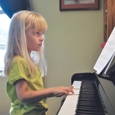
Teachers introduce young flutists to a complex new language as they begin to teach them to read and understand music. Many aspects of this language are brand new to them. It is helpful to connect new concepts to ones they already understand: we teach rhythm, for example, by linking it to math, and articulation by comparing it to spoken consonants, or to spitting rice.
The concepts involved in basic music theory can be especially challenging for young musicians. Those who have studied piano have an advantage because the piano presents a visual and tactile experience with music theory, so that such ideas as half and whole steps, scale structure, and the idea of the octave become visible and tangible.
Although most flute teachers already use the piano as a practical tool in the studio, the following are some additional applications that will assist in conveying basic concepts of music theory to beginning students. In addition, serious musicians should achieve a certain comfort level with the piano. When teachers introduce the instrument early, they give their students an advantage in developing this necessary skill. Just as we expect that students should know how to use a dictionary in school, young musicians should be able to find their way around a piano. In the long run, using the piano as a teaching tool during lessons actually saves time that would otherwise be spent explaining or correcting concepts that were misunderstood initially.
I use the piano to briefly illustrate new concepts as they are introduced on the flute. When a student first encounters an F#, for example, we take a few minutes to observe the general layout of the keyboard, to find an F#, and to discover other F#s and how they sound compared with F# on the flute. I want my students to know that even if they have never taken piano lessons, they can understand and use the geography of a keyboard.
As they learn more notes students are interested to compare their own expanding range with the three-octave span used by flutists, and to see where these three octaves fall on the piano. Discovering that a half step can include a black key and a white key or two white keys, and then constructing half- and whole-step dissonances across the keyboard is a great listening exercise. The new musical vocabulary of consonance and dissonance and tension and release begins to make sense.
When students start to play scales, the piano provides a perfect opportunity to put their understanding of half and whole steps to use. I ask them to play each new scale they learn on both flute and piano, and to notice the location and sound of the half steps. When the chromatic scale is introduced, we explore enharmonic names and the idea of double sharps and flats. Often these concepts are confusing even to older students, until they see that a B# is really the same as a C, and that because they know F# they already know the fingering for Gb.
Befriending the piano also makes possible some discoveries about melody and harmony. Playing two notes simultaneously on the flute is an advanced skill, but it is easy on piano, and opens up a new realm of listening and comparing sounds. It is important for developing flutists to realize that their ability to sustain sound with breath distinguishes them from pianists, whose tone begins to disappear as soon as it is produced. This realization is the best motivation I can think of for a young flutist to learn how to breathe well and manage the airstream.
Once a young flutist is confident with reading notes in the treble clef, it is not hard to extend that understanding to reading the bass clef. When the mystery of the bass clef is gone, they can look at a whole score and discover how the flute and piano parts intersect. Students who are ready to play accompanied pieces should practice with the score. Their ability to understand the notation of the piano part makes possible a full understanding of the composer’s intention. Not all students will be fascinated by score study, of course, but my hope is that some of them will be as intrigued by deciphering the wealth of information in a score as they are by reading an engrossing book.
Here are some keyboard activities for young flutists:
• Find all the Ds, Bbs, etc. on the piano
• Play half and whole steps
• Play a major scale; name the notes and notice where the half steps fall
• Play a chromatic scale; name the notes and notice the half steps
• Give two names (spellings) for a given key
• Play a whole tone scale
• Find the top and bottom notes of the student’s range on the piano. Repeat periodically as more notes are learned
• As the teacher plays the interval of a fifth on the piano, the student plays the major or minor third on flute to experience the sounds of both triads. Reverse roles.
Related activities will be generated by students’ questions, their interest levels, and how much time you choose to spend at the keyboard. There are endless other activities using the piano related to the music your students are playing. Find the ones that seem to be best suited to your own students, and then enjoy the moments as they say, “I get it now!”






